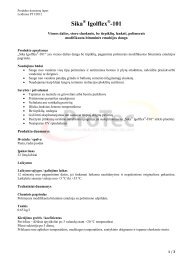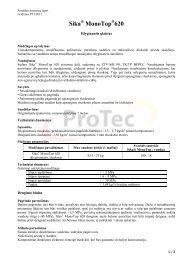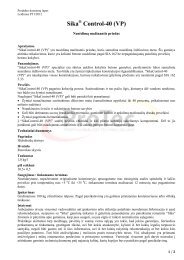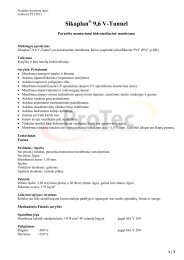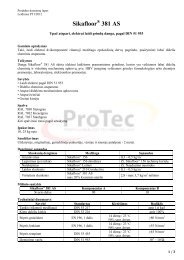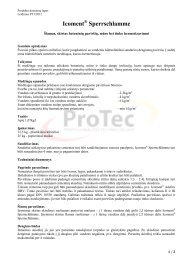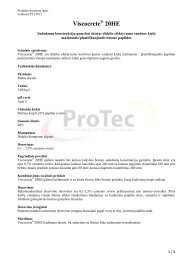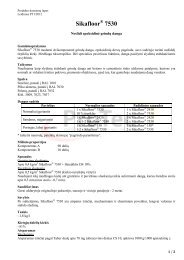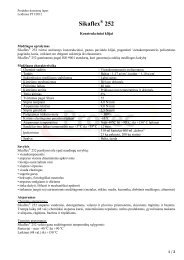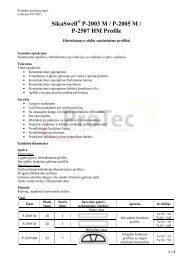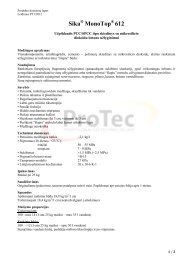Sikaflex Marine Handbook
Sikaflex® Marine Handbook - BlueMoment
Sikaflex® Marine Handbook - BlueMoment
- No tags were found...
You also want an ePaper? Increase the reach of your titles
YUMPU automatically turns print PDFs into web optimized ePapers that Google loves.
Instructions ForBonding of Rub Rails and FendersInstructions for BondingRub Rails to HullDescription of ApplicationRub rails and fenders are designedto protect the hull of a ship or boatagainst damage. They act as abumper to absorb impacts andscrapes, and the more elastic theyare, the more effectively they canperform this function.Their elastic behaviour variesaccording to the type of materialused. The shock-absorbingperformance of the rub rail issignificantly improved by the useof an elastic adhesive joint. Thisaffords maximum protection to thehull.Rub rails of conventional timber,PVC or polyurethane constructioncan be securely bonded to marinehulls using <strong>Sikaflex</strong> ® -292. Theresulting elastic joint helps toabsorb most of the shear andtensile stresses to which rub railsare subjected when a vessel isdocking or casting off.In the case of rub rails securedwith screws, a similar effect can beobtained by backfilling the railprofile with <strong>Sikaflex</strong> ® -291, a highlyelastic polyurethane sealant. Aswell as absorbing torsionalstresses, this also seals the screwholes and prevents the ingress ofwater or dirt behind the rub rail.Preparation of SubstrateGRP Hulls205206 G+P/215Heavily soiled surfaces should becleaned off first with a pure solvent(Sika ® Remover-208) to remove theworst of the soiling.Lightly abrade contact area with avery fine sanding pad. Remove dustwith a vacuum cleaner.Clean the substrate with Sika ®Cleaner-205, using a clean, lint-freerag or paper towel. Changefrequently!Drying time: minimum 10 minutes,maximum 2 hoursApply a thin, continuous coat ofSika ® Primer-206 G+P or Sika ®Primer-215, using a clean brush orfelt applicator.Drying time: minimum 30 minutes,maximum 24 hoursFinished Painted Hulls of Aluminium orSteel, Coated with Two-part Lacquer205Clean the substrate with Sika ®Cleaner-205, using a clean, lint-freerag or paper towel. Changefrequently!Drying time: minimum 10 minutes,maximum 2 hoursTimber Rub Rails290 DCAbrade contact area on hull withsanding pad (80/100 grit) and removedust with a vacuum cleaner.Apply a thin, continuous coat of Sika ®Primer-290 DC, using a clean brush orfelt applicatorDrying time: minimum 60 minutes,maximum 24 hours.Moulded PVCor Polyurethane Rub Rails205The bond face of the rub rails must befree from mould release agents orother chemical contaminants. Alltraces of such substances must beremoved prior to proceeding.Abrade the bond face of the rub railwith coarse sand paper (60/80grit) tokey the surface.Clean the substrate with Sika ®Cleaner-205, using a clean, lint-freerag or paper towel. Change ragfrequently!Drying time: minimum 10 minutes,maximum 2 hoursApplication of <strong>Sikaflex</strong> ® -292/291 Adhesive/SealantPlace elastic spacers in position (thickness 2 mm, approximately 50 Shore A hardness).Apply <strong>Sikaflex</strong> ® -292 (or <strong>Sikaflex</strong> ® -291 if rub rails are to be secured using additionalmechanical fixation) in an 8 mm x 10 mm triangular bead to the proposed bond area.Assemble components within 20 minutes of applying adhesive.Because of the variable composition of rubrails, an adhesivon test is advised prior toinstallation.Press the rub rail into place, either directly onto the face of the hull or fitted over the coreprofile. Use clamps, etc. to hold the rub rail in position while the adhesive sets. If the rubrail is to be secured with mechanical fixings, any holes should also be filled with adhesive.Clamps and other fastening aids can be removed after 24 hours.Full service strength is attained after approximately 7 days.208Traces of uncured Sika adhesives or sealants may be removed with Sika ® Remover-208. Onno account should other cleaning agents or Sika ® Cleaner-205 be used for this purpose.14Important: Please refer to the current Sika Technical Data Sheets and Safety Data Sheets obtainable through Sika or theirlocal distributor.



